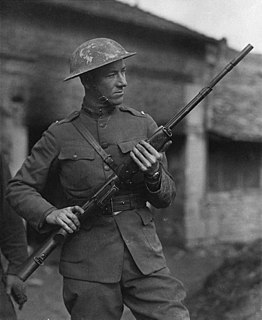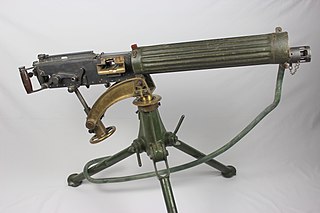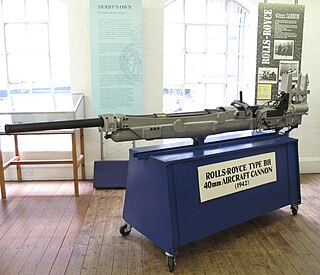Related Research Articles

A general-purpose machine gun (GPMG) is an air-cooled, usually belt-fed machine gun that can be adapted flexibly to various tactical roles for light, medium and even heavy machine guns. A GPMG will typically feature a quick-change barrel design calibered for various fully powered cartridges such as the 7.62×51mm NATO, 7.62×54mmR, 7.5×54mm French, 7.5×55mm Swiss and 7.92×57mm Mauser, and be configured for mounting to different stabilizing platforms from bipods and tripods to vehicles, aircraft, boats and fortifications, usually as an infantry support weapon.

A machine gun is a rapid-firing, rifled long-barrel autoloading firearm designed for sustained direct fire with fully powered cartridges. Other automatic firearms such as assault rifles and automatic rifles are really designed more for unleashing short bursts rather than continuous firepower, and not considered machine guns. Squad automatic weapons, which fire the same cartridge used by the other riflemen from the same combat unit, are functionally light machine guns though not called so. Submachine guns, which are capable of continuous rapid fire but using handgun cartridges, are also not technically regarded as true machine guns.

A submachine gun, abbreviated SMG, is a magazine-fed, automatic carbine designed to fire handgun cartridges. The term "submachine gun" was coined by John T. Thompson, the inventor of the Thompson submachine gun, to describe its design concept as an automatic firearm with notably less firepower than a machine gun. As a machine gun must fire rifle cartridges to be classified as such, submachine guns are not considered machine guns.

The Lewis gun is a First World War–era light machine gun. Designed privately in America but not adopted, the design was finalised and mass-produced in the United Kingdom, and widely used by troops of the British Empire during the war. It had a distinctive barrel cooling shroud and top-mounted pan magazine. The Lewis served to the end of the Korean War. It was also widely used as an aircraft machine gun, almost always with the cooling shroud removed, during both World Wars.

The M2 machine gun or Browning .50 caliber machine gun is a heavy machine gun designed toward the end of World War I by John Browning. Its design is similar to Browning's earlier M1919 Browning machine gun, which was chambered for the .30-06 cartridge. The M2 uses the much larger and much more powerful .50 BMG cartridge, which was developed alongside and takes its name from the gun itself. It has been referred to as "Ma Deuce", in reference to its M2 nomenclature. The design has had many specific designations; the official US military designation for the current infantry type is Browning Machine Gun, Cal. .50, M2, HB, Flexible. It is effective against infantry, unarmored or lightly armored vehicles and boats, light fortifications, and low-flying aircraft.

The .50 Browning Machine Gun is a .50 in (12.7 mm) caliber firearm cartridge developed for the M2 Browning machine gun in the late 1910s, entering official service in 1921. Under STANAG 4383, it is a standard service cartridge for NATO forces as well as many non-NATO countries. The cartridge itself has been made in many variants: multiple generations of regular ball, tracer, armor-piercing (AP), incendiary, and saboted sub-caliber rounds. The rounds intended for machine guns are made into a continuous belt using metallic links.

Fabrique National Herstal, self-identified as FN Herstal and often referred to as Fabrique Nationale or simply FN, is a leading firearms manufacturer located in Herstal, Belgium, owned by the holding company Herstal Group which is in turn owned by the regional government of Wallonia. It is currently the largest exporter of military small arms in Europe.

A gunship is a military aircraft armed with heavy guns, primarily intended for attacking ground targets.

The Browning Automatic Rifle (BAR) is a family of American automatic rifles and machine guns used by the United States and numerous other countries during the 20th century. The primary variant of the BAR series was the M1918, chambered for the .30-06 Springfield rifle cartridge and designed by John Browning in 1917 for the American Expeditionary Forces in Europe as a replacement for the French-made Chauchat and M1909 Benét–Mercié machine guns that US forces had previously been issued.

An automatic rifle is a type of self-loading rifle that is capable of automatic fire. Automatic rifles are select-fire weapons that are capable of firing in semi-automatic and automatic firing modes. Automatic rifles are distinguished from semi-automatic rifles in their ability to fire more than one shot in succession once the trigger is pulled. Most automatic rifles are further subcategorized as battle rifles or assault rifles.

The Vickers machine gun or Vickers gun is a name primarily used to refer to the water-cooled .303 British (7.7 mm) machine gun produced by Vickers Limited, originally for the British Army. The machine gun typically required a six- to eight-man team to operate: one fired, one fed the ammunition, the rest helped to carry the weapon, its ammunition, and spare parts. Not to be confused with the Maxim machine gun, it was in service from before the First World War until the 1960s, with air-cooled versions of it on many Allied World War I fighter aircraft.

A revolver cannon is a type of autocannon, commonly used as an aircraft gun. It uses a cylinder with multiple chambers, like those of a revolver handgun, to speed up the loading-firing-ejection cycle. Some examples are also power-driven, to further speed the loading process. Unlike a rotary cannon, a revolver cannon has only a single barrel, thus its spun weight is lower. Automatic revolver cannons have been produced by many different manufacturers.

A heavy machine gun or HMG is a belt-fed machine gun that fires full-powered/magnum cartridges and is designed to be significantly more massive than light, medium or general-purpose machine guns. As the name implies, heavy machine guns are typically not man-portable by infantry and thus require mounting onto a weapons platform to be operably stable or tactically mobile, have more formidable firepower, and generally require a team of personnel for operation and maintenance.

The Colt–Browning M1895, nicknamed "potato digger" because of its unusual operating mechanism, is an air-cooled, belt-fed, gas-operated machine gun that fires from a closed bolt with a cyclic rate of 450 rounds per minute. Based on a John Browning and Matthew S. Browning design dating to 1889, it was the first successful gas-operated machine gun to enter service.

The 1.1"/75 caliber gun was an American anti-aircraft weapon of World War II, used by the United States Navy. The name means that it had a bore diameter of 1.1 in (28 mm) and barrel caliber of 75. The gun was designed to replace the M2 Browning and four barrels were required to duplicate the rate of fire. The first shipboard installation in 1939, was quickly nicknamed the Chicago Piano, possibly because it was the size of a baby grand piano and looked a little like a baby grand without its lid. The name also references the "tommy guns" used by gangsters in Chicago.

An assault rifle is a selective-fire rifle that uses an intermediate cartridge and a detachable magazine. Assault rifles were first put into mass production and accepted into widespread service during World War II. The first assault rifle to see major usage was the German StG 44, a development of the earlier Mkb 42. Though other Western nations were slow to accept the assault rifle concept, by the end of the 20th century they had become the standard weapon in most of the world's armies, replacing full-powered rifles and sub-machine guns in most roles. Besides the StG 44, examples of assault rifles include the AK-47 and the M16.

The M1919 Browning is a .30 caliber medium machine gun that was widely used during the 20th century, especially during World War II, the Korean War, and the Vietnam War. The M1919 saw service as a light infantry, coaxial, mounted, aircraft, and anti-aircraft machine gun by the U.S. and many other countries.

The M13 Multiple Gun Motor Carriage (MGMC), otherwise known as the M13 half-track, was a self-propelled anti-aircraft gun used by the U.S. Army during World War II that was armed with two .50 caliber M2HB heavy-barrel Browning machine guns. Developed in response to a requirement for a mobile anti-aircraft (AA) vehicle, the vehicle was produced by the White Motor Company between July 1942 and May 1943. The only time it was ever used in combat was when the Americans landed at Anzio in January 1944. It was replaced by the more heavily armed M16 Multiple Gun Motor Carriage in April 1944.

The M15 half-track, officially designated M15 Combination Gun Motor Carriage, was a self-propelled anti-aircraft gun on a half-track chassis used by the United States Army during World War II. It was equipped with one M1 automatic 37 millimeter (1.5 in) gun and two water-cooled .50 caliber (12.7 mm) M2 Browning heavy machine guns. Based on the M3 half-track chassis, it was produced by the White Motor Company and Autocar between July 1942 and February 1944, and served alongside the M16 Multiple Gun Motor Carriage.

The Rolls-Royce 40mm Cannon was a project first proposed in late 1938 to produce a cannon for mounting in aircraft which could cause sufficient damage to bring down a large bomber. It was also envisioned to be a suitable weapon for destroying tanks from the air. Experimental versions of the cannon were produced including some with a magazine or belt feed for the ammunition. Examples were fitted to a Beaufighter and Hurricane for testing, although never used in action. Continued development of the aircraft cannon to iron out problems came to an end in 1943 when the Air Ministry lost interest in it and had started to favor the rocket projectile as its aircraft anti-tank weapon of choice.
References
- Notes
- Bibliography
- Birch, David. Rolls-Royce Armaments. Derby, UK: Rolls-Royce Heritage Trust. 2000. ISBN 1-872922-15-5.
- Hogg, Ian V. and Weeks, John S. Military Small Arms of the 20th Century. Iola WI: Krause. 7th Edition, 1990. ISBN 0-87341-824-7.
| | This United Kingdom military article is a stub. You can help Wikipedia by expanding it. |
| | This firearms-related article is a stub. You can help Wikipedia by expanding it. |